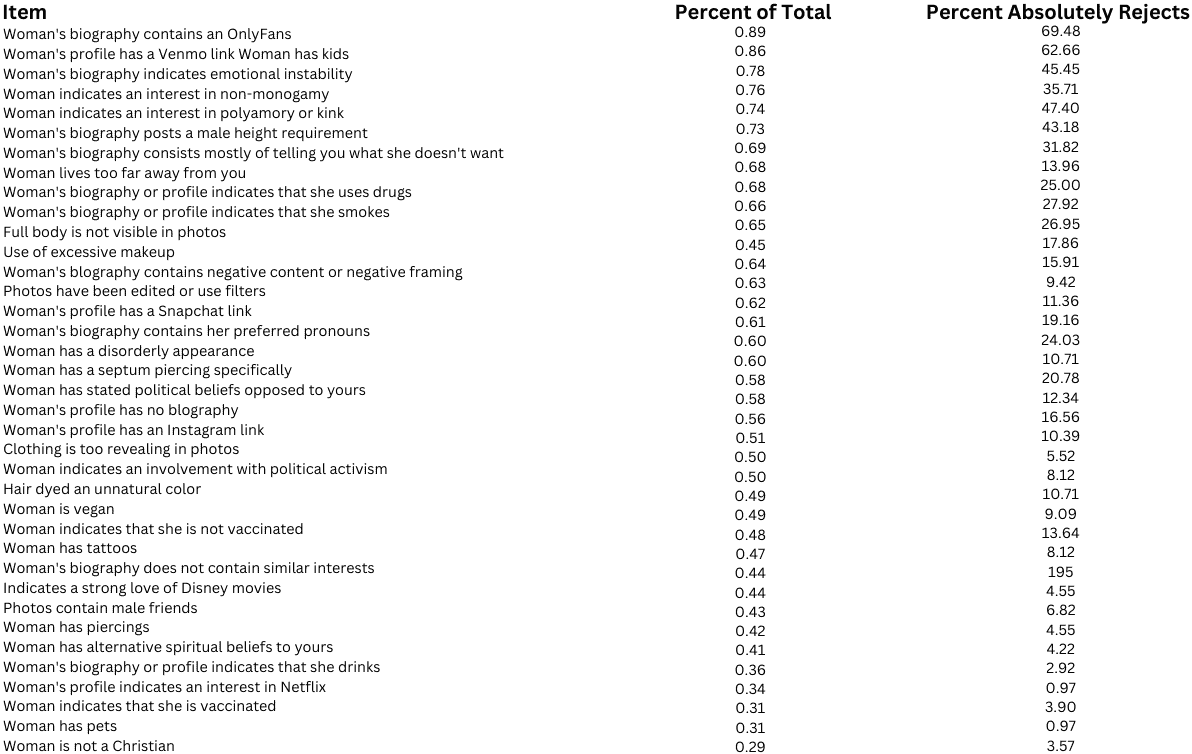What’s the ultimate turn-off on dating apps? Apparently, a study found the most common deal-breakers in online dating.
There are significant factors that cause people to lose interest in people when scrolling through prospective matches on dating apps, and it has identified the most common icks in online dating.
Date Psychology coded 130 tweets detailing dating app dealbreakers and split them up by gender into survey questions. Ninety-one percent of the survey’s respondents identified as heterosexual, ten percent as bisexual, and one percent as LGBTQIA+.
When it comes to deal-breakers, participants were prompted to envision a dating profile where the photo was hot enough to make them swipe right faster than a lion chasing a gazelle–the objective was for people to evaluate deal-breakers even when the person in the profile pic is HOT.
The rating of deal-breakers was done on a scale ranging from 1 to 5. A score of 1 indicates a high willingness to make concessions or ignore a deal-breaker. A rating of 5 signifies an unchangeable factor that will result in the user swiping left or dismissing the profile, regardless of how attractive the individual in the photo looks.

Profile Deal-Breakers
The study suggests that portraying aggression or violence in one’s profile is among the least desirable traits for a man. According to the survey, 84 percent of respondents stated it would be a definite deal-breaker. According to the survey, only 79 percent of respondents stated that they consider a man’s profile featuring something racist as a deal-breaker.
The survey indicated that just 70% of men would swipe left on a woman if her bio included a link to her OnlyFans account. One of the top two deal-breakers for males was a woman who asked for money in her bio.
Profiles with links to Venmo or Cash App were the second-worst thing to see in women’s profiles, accounting for around 63 percent of men.
Some of the reasons for “swiping left” in the study were rather minor; for example, 5% of respondents said they wouldn’t date an adult woman who adores Disney. And 5% of women would never go out with a man with a profile photo of him wearing a hat.
Most people do not consider owning pets a deal-breaker, and only 23% of women and 17% of men consider the lack of a bio as a significant factor that would end their interest in someone.
Few of the media-cited deal-breakers were not deemed to be major issues by the women who participated in this poll. Just 16.92% of women said they would never consider a man who uploaded a shirtless photo on his profile. Despite the alleged practice of “hatfishing,” or donning a hat to disguise baldness, just 5.38 percent of women said they would turn down a man who wore a hat. Similar percentages of people (3% and 1.54%, respectively) said they would dismiss a profile of a male wearing sunglasses or not smiling.
For a sizeable proportion of women, polarizing topics that represent politics or ideology are a dealbreaker. 43% of women said they would not contact someone whose profile suggested they had opposing political opinions; 27.69% said they wouldn’t contact someone whose profile included preferred pronouns; and 17.69% said they wouldn’t contact someone whose profile indicated they were in law enforcement, the military, or had served in the armed forces. Twenty-seven percent said they wouldn’t go for a man whose profile mentioned or demonstrated gun ownership, and 10 percent said they wouldn’t go for a man who enjoyed outdoor activities like hunting or fishing. Only 19.23% of women would consider dating a vegan man.
Putting up “laundry lists” or “what I don’t want” lists in one’s profile also rated high as a deal-breaker for women, but not so much for males. Men, even tall ones, ranked a “male height requirement” high on their list of deal-breakers.
Deal-breaker Comprehensive Results/Scores
Here are tables displaying the deal-breaker ratings for both sexes. The leftmost column displays the proportion of possible points. The right column shows the share of participants who gave that item a 5 or who would definitely not date someone with that profile aspect.
Differences in Sexual Preferences Between Genders Regarding Monogamy and Casual Sex
When looking at the entire sample, the study found that men and women differed in their desire for monogamy and their willingness to engage in casual sexual encounters.
The average man scored 2.99 (SD 1.39), while the average woman scored 1.94 (SD 1.23). There was a considerable effect size (Cohen’s d = 0.84, 95% CI [0.63, 1.05]) and a statistically significant distinction between the groups t(307.62) = 8.86, p .001, CI [0.82, 1.92]).


For males, the average score was 4.14 (standard deviation of 1.17), whereas, for women, it was 4.49 (standard deviation of 1.21).
“The effect scale was minor (Cohen’s d = -0.35, 95% CI [-0.55, -0.14]), but the difference was statistically significant (t(289.72) = -3.59, p =.0004),” according to the study.

Current Vs. Previous Dating App Use
To analyze the correlation between sexual orientation and prior usage of dating apps, the study administered a Pearson’s chi-squared test with Yates’ correction.
The analysis showed that there was no significant association, with a chi-square value of 2.4275 and a p-value of 0.1192, based on a sample size of 438. According to the data, a significant number of both men and women have used dating apps in the past. Specifically, 76.92% of women and 83.61% of men reported having used a dating app at some point.
Nonetheless, there were notable differences between males and females in their present usage of the app (X²(1, N = 438) = 8.3056, p = 0.004). 41.67% of men reported being current users of dating apps, compared to 26.15% of women who reported the same.

Influence of Male Height
On one deal-breaker item, the study found that male height had a small but significant effect (S = 6380890, rho = -0.31, p .001). Taller men were less likely to think that a woman’s height requirement was a deal-breaker.
On the other hand, there was no significant correlation between a man’s height and his standards or deal-breaker scores. This was evidenced by a Pearson correlation coefficient of -0.04, based on a sample size of 306, with a p-value of 0.455 and a 95% confidence interval ranging from -0.1537 to 0.0694. The study found no significant correlation between a man’s height and his likelihood of considering a woman’s inclusion of “her preferred pronouns in her dating profile as a deal-breaker (S = 4906987, rho = -0.0077, p = 0.8933),” it revealed.
Final Thoughts
Women are more cognizant of deal-breakers than men are, even when comparing essentially identical things.
For males, dating a single parent was an exception; 45.45% said they would never date a woman with children. This item ranked third highest among men, following the inclusion of an OnlyFans account or a request for money in their dating bio. In comparison, 30.77% of women said they would categorically reject a potential match who is a single parent–this was item 14 when it came to deal-breakers for women.
Women were more likely to reject a partner who practiced non-monogamy than males. A total of 47.4% of males and 74.62% of women stated they would never date a woman whose profile included any hint of interest in polyamory–for females, this was the sixth item on the list of deal-breakers.
This is probably because men and women vary in regard to whether they want to be monogamous and how open they are to casual sex, according to the data and past studies. When casual sex is on the table, men are often far more open to it. Clark and Hatfield’s (1989) seminal study is an excellent illustration of this principle. Most men would immediately agree to a woman’s sexual proposal if she were attractive enough, and all the women said no when an attractive stranger proposed having sexual interactions with them.






